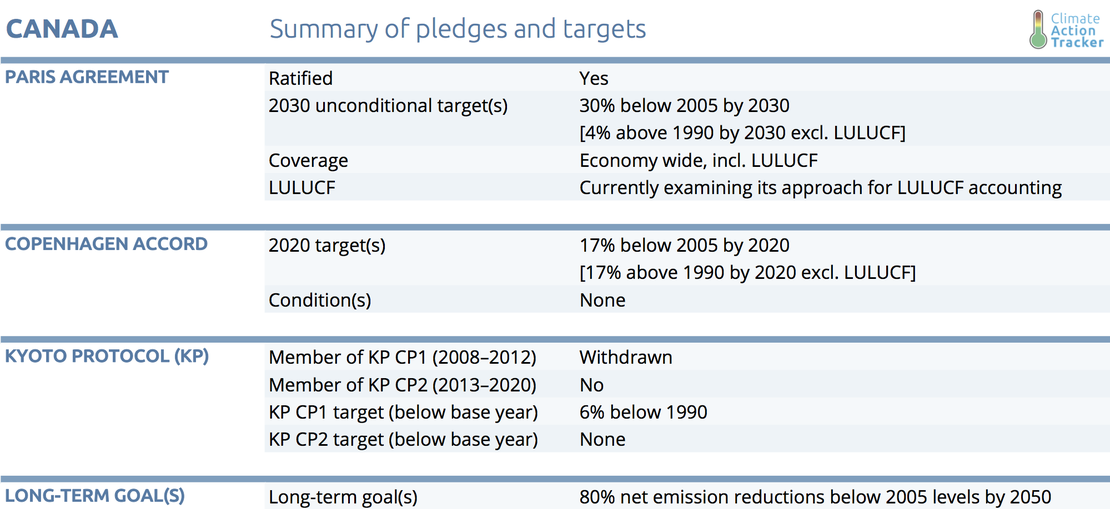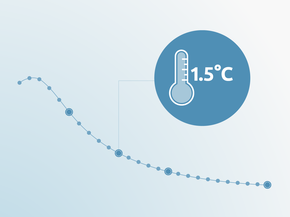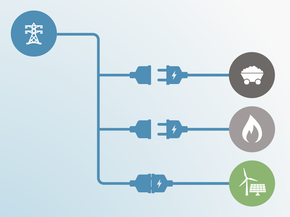Pledges And Targets
Paris Agreement
Canada states in its NDC that it will pursue an economy-wide target to reduce GHG emissions to 30% below 2005 levels by 2030. Canada has indicated that it may also use international credits to meet its target. Considering the upward trajectory of the upper bound of the current policy projection, Canada may need to use a large quantity of international credits to meet its target.
Despite indications that LULUCF has been excluded throughout NC7 it is not entirely clear which LULUCF accounting approach will be employed. Nonetheless to align with what appears to be the approach used in calculating the NDC target emissions level in NC7, we calculated the target by excluding LULUCF in the base year (2005) before applying the 30% decrease. We estimate the emissions level under the 2030 target is 504 MtCO2e excluding LULUCF[1]. The NDC target excluding LULUCF is equivalent to a 30% reduction from 2005 and 15% reduction from 1990 levels of GHG emissions. This target emissions level corresponds to a CAT rating of “Insufficient.”
However, Canada is considering if and how it will use LULUCF accounting in GHG reporting in the future, which could impact its ability to achieve its NDC targets. It is not yet clear if this will be allowed under the Paris Agreement rulebook, which has yet to be agreed upon. To reflect the uncertainty surrounding Canada’s LULUCF accounting method, the CAT also provides an NDC target level reflecting a gross-net LULUCF accounting approach to provide an indication of what the target could be if Canada where to fully rely on its projected LULUCF sink in 2030 to achieve the target. Based on LULUCF projections from the Sixth National Communication, by employing the gross-net[2] approach to LULUCF accounting, Canada could potentially rely on a LULUCF sink of 142 MtCO2e, which would increase their target emissions level to 646 MtCO2e, excl. LULUCF. This target emissions level corresponds to a CAT rating of “Highly insufficient.”
Given these uncertainties we rate the NDC target “Highly insufficient” as Canada has indicated that it will use emissions reductions from the LULUCF sector to achieve the target.
Both approaches differ from the one used in the 2016 CAT update for Canada, which was similar to that of the revised NDC, meaning the target was calculated including LULUCF in the base year.
Canada’s revised NDC states that it will use “the IPCC production approach” to account for Harvested Wood Products (HWPs). The National Inventory Report (NIR) 1990-2015 therefore uses the IPCC production approach and reports emissions associated with wood from forest harvest and forest conversion activities. Accounting for HWPs must be performed in a consistent and compatible manner across countries so that accounting of imported and exported HWPs is complete, and emissions are not excluded from inventories. The new inventory accounts for emissions due to imports and exports of HWPs. However, as explained below, it excludes emissions from natural disturbances (e.g. forest fires and insect outbreaks).
Canada’s 2017 inventory report changed compared to previously calculated emissions for all the IPCC sectors. To calculate LULUCF emissions and removals, Canada has developed a new methodology that accounts for emissions due to human activity—excluding the impacts of natural disturbances in managed forests (Government of Canada, 2017b). The inventory also includes the new British Colombia forest inventory. Data has also been updated and some model parameters in other LULUCF sub-sectors have been revised (Government of Canada, 2017b). The National Inventory Report (NIR) and NC7 state that Canada is temporarily excluding emissions from forested areas dominated by natural disturbances. The excluded emissions will be included once these forested areas attain commercial maturity and are affected by forest management activities. Currently it is not clear whether countries may exclude emissions due to natural disturbances from their inventories under IPCC guidelines.
[1] The target emissions level calculated in the CAT assessment is different from the target of 523 MtCO2e stated in the revised NDC because of our alignment with the NC7 calculation approach, as well as the use of global warming potentials (GWP) from the Second Assessment Report (SAR), instead of the 4th Assessment Report (AR4) (see Assumptions for further details).
[2] The gross-net accounting approach excludes LULUCF emissions in the base year but includes them in the target year.
2020 pledge and Kyoto Protocol
Canada's Kyoto Protocol target for the first commitment period 2008–2012 was a reduction of 6% below 1990 levels. However, in December 2011, Canada withdrew from the Kyoto Protocol.
Canada's Copenhagen pledge aims to reduce emissions by 17% below 2005 levels by 2020 incl. LULUCF (17% above 1990 levels excl. LULUCF) (Government of Canada, 2010). The Copenhagen commitment, based on 2005 levels, aligned Canada’s level of ambition to the United States, which also targets a 17% reduction in emissions from 2005 levels by 2020.
Long-term goal
In 2016, Canada proposed a mid-century, long-term low greenhouse gas development strategy (Government of Canada, 2016a). This strategy contains an emissions reduction pathway that is consistent with net emissions falling by 80% in 2050 from 2005 levels. The strategy documentation indicates that this target equates to a 65% reduction in emissions below 2005 levels when LULUCF credits are taken into account (Government of Canada, 2016a). Canada intends to regularly update this long-term strategy as national circumstances change and low-GHG technologies evolve.

Further analysis
Latest publications
Stay informed
Subscribe to our newsletter






